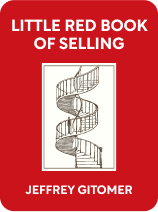

This article is an excerpt from the Shortform book guide to "Little Red Book of Selling" by Jeffrey Gitomer. Shortform has the world's best summaries and analyses of books you should be reading.
Like this article? Sign up for a free trial here .
What role does creativity play in sales? How does creativity contribute to sales success?
Creativity is not typically something employers look for when hiring sales professionals. But imbuing your sales pitch with a little creativity can increase prospect engagement and boost your chances of closing the deal.
Here are four ways you can use creativity in your sales pitch.
Solve Your Sales Struggles With Creativity
Creativity will make you and your sales pitch stand out and be remembered. Here are four ways to use creativity in sales:
1) At the start of a sales call, ask a smart, unexpected opening question instead of blathering on about your company and product. For example, ask: “How much does a lost hour of productivity cost your company?” or “How would you know if you were overpaying for printing?”
2) Identify every customer contact point, and change it so it’s distinctive—including the voicemails you leave, your cover letter, your phone greeting or voicemail message, your business cards, and so on.
Fixing your voicemail message is the most important step because it can help you get new customers and act as word-of-mouth advertising (if you have a unique message, people will tell others about it). Virtually everyone’s message starts the same way, by intoning, “I’m either on the phone or away from my desk…” Some messages tell callers what day it is and what you’re doing (“I’ll be in meetings this morning…”), although the caller doesn’t care or need to know.
If you claim to be different from your competitors, your voicemail message should reflect that. Here are some ways to create a memorable message:
- Make a short statement about the value of your product—for example, tell customers one way they can profit from it.
- Use a thought-provoking quote (change it daily)
- If you’re good at imitation, try speaking in a celebrity voice, using a familiar line.
- Record a message from one of your kids (“Hi, I’m Josh. Dad is out earning my college tuition…”)
- Make a joke that’s general, or one specific to your business (“Hi, I’m in my company’s genius training program at the moment…” or “You’ve reached Tom at Premier Pest Control. I want to know what’s bugging you, so leave a message…”)
- Record a testimonial from a customer. (“I’m Dave. I’ve been pain-free for five years, thanks to Wilson Chiropractic—I hope you’ll let them help you too.”)
- Make an off-the-wall joke: One of the author’s messages was: “Hi, this is Jeffrey. Please leave your Visa credit card number and expiration date and I’ll get back to you.” (A few people actually left credit card numbers.)
Keep your message short—35 words or less. Write it out, practice it until you can record it perfectly, then change it often (preferably weekly).
3) Use creative follow-up contacts to keep in touch with a customer after a meeting—for instance, email a weekly tip about your area of expertise, share useful information and testimonials, or send a newsletter.
4) Respond creatively to buyer objections. For example, when a prospect tells you she’s satisfied with her current supplier or product, you might respond: “Prospective clients often claim they’re satisfied with what they have—however, our customers tell us they’re thrilled. Wouldn’t you rather be thrilled than just satisfied?”
How to Cultivate Creativity
You can develop creativity by studying and practicing it. Here are some attributes and practices that facilitate creativity:
- Maintain a positive attitude: This is important because negative thoughts and feelings block creativity. That’s why you think of the perfect response only after an argument—negativity clouds your thinking.
- Write down ideas: Creative ideas pop into your head quickly, then just as quickly vanish. So anytime you get an idea, write it down, and try to elaborate on it while it’s fresh.
- Believe in your creative potential: Stop telling yourself you aren’t creative. You have to believe in yourself for ideas to flow, so affirm your creativity by telling yourself you have a wealth of ideas waiting to be tapped.
- Create a workspace that’s conducive to creativity. For example, if you work best in stimulating surroundings, create that kind of space.
- Find creative mentors who support and inspire your creativity.
- Study creativity: Read works by creative writers and books about how others have developed creativity—for example, the Dr. Seuss books and Michael Michalko’s Thinkertoys and Cracking Creativity. (Shortform note: For the story of how Ed Catmull fostered creativity as Pixar, read our summary of Creativity, Inc.)
- Use creative models and tools such as SCAMPER, which walks you through a series of questions to prompt multiple perspectives on an idea or thought. (SCAMPER is an acronym for Substitute, Combine, Adapt, Modify, Maximize or Minimize, Put to another use, Eliminate, Reverse.)
- Be willing to risk failure: Failure is part of the creative process—it teaches you how to improve your ideas. Inventor Thomas Edison welcomed his failures as steps on the way to success.

———End of Preview———
Like what you just read? Read the rest of the world's best book summary and analysis of Jeffrey Gitomer's "Little Red Book of Selling" at Shortform .
Here's what you'll find in our full Little Red Book of Selling summary :
- Jeffrey Gitomer’s 13 principles of selling
- How to eliminate hurdles and win more sales
- The reasons why people buy even though they don't like being sold to






